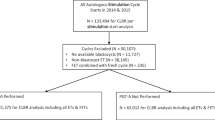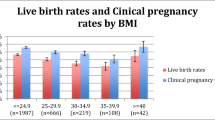Abstract
Purpose
Are trends in singleton autologous IVF perinatal outcomes consistent over time among five international infertility centers?
Methods
This was a retrospective cohort study from January 1, 2012, to December 31, 2018. This study was performed through a large infertility network at five international infertility centers in which patients who had a singleton live birth resulting from fresh and frozen autologous IVF cycles were included. The primary outcome was live birth weight (BW) with secondary outcomes of preterm birth (PTB), large for gestational age (LGA), small for gestational age (SGA), and gestational age at delivery.
Results
The entire cohort (n = 13,626) consisted of 6941 fresh and 6685 frozen autologous IVF cycles leading to singleton deliveries. Maternal age, parity, body mass index, neonatal sex, and GA at delivery were similar for fresh and frozen IVF cycles in the entire cohort and within each infertility center. Four centers had a trend of decreased BW and three centers had decreased rates of PTB before 32 and 28 weeks and LGA newborns annually, although significance was not reached. Three IVF centers had annual increased trends of PTB before 37 weeks and four centers had increased rates of SGA newborns, although significance was not reached.
Conclusion
Similar trends in perinatal outcomes were present across five international infertility centers over 7 years. Additional studies are crucial to further assess and optimize perinatal outcomes at an international level.
Similar content being viewed by others
References
Fauser BC. Towards the global coverage of a unified registry of IVF outcomes. Reprod Biomed Online. 2019;38:133–7.
Zer S, Wainstock T, Sheiner E, Miodownik S, Pariente G. Identifying the critical threshold for long-term pediatric neurological hospitalizations of the offspring in preterm delivery. J Clin Med. 2021;10:2919.
Allotey J, Zamora J, Cheong-See F, Kalidindi M, Arroyo-Manzano D, Asztalos E, et al. Cognitive, motor, behavioural and academic performances of children born preterm: a meta-analysis and systematic review involving 64061 children. BJOG An Int J Obstet Gynaecol. 2018;125:16–25.
Løhaugen GCC, Ostgård HF, Andreassen S, Jacobsen GW, Vik T, Brubakk AM, et al. Small for gestational age and intrauterine growth restriction decreases cognitive function in young adults. J Pediatr. 2013;163:447–54.
Nesbitt TS, Gilbert WM, Herrchen B. Shoulder dystocia and associated risk factors with macrosomic infants born in California. Am J Obstet Gynecol. 1998;179:476–80.
Gupta N, Kiran TU, Mulik V, Bethel J, Bhal K. The incidence, risk factors and obstetric outcome in primigravid women sustaining anal sphincter tears. Acta Obstet Gynecol Scand. 2003;82:736–43.
Luyckx VA, Bertram JF, Brenner BM, Fall C, Hoy WE, Ozanne SE, et al. Effect of fetal and child health on kidney development and long-term risk of hypertension and kidney disease. Lancet. 2013;382:273–83.
Skilton MR, Siitonen N, Würtz P, Viikari JSA, Juonala M, Seppälä I, et al. High birth weight is associated with obesity and increased carotid wall thickness in young adults: the cardiovascular risk in young Finns study. Arterioscler Thromb Vasc Biol. 2014;34:1064–8.
Zandstra H, Van Montfoort APA, Dumoulin JCM. Does the type of culture medium used influence birthweight of children born after IVF? Hum Reprod. 2015;30:530–42.
Kleijkers SHM, Mantikou E, Slappendel E, Consten D, Van Echten-Arends J, Wetzels AM, et al. Influence of embryo culture medium (G5 and HTF) on pregnancy and perinatal outcome after IVF: a multicenter RCT. Hum Reprod. 2016;31:2219–30.
Chronopoulou E, Harper JC. IVF culture media: past, present and future. Hum Reprod Update. 2015;21:39–55.
Shah JS, Vaughan DA, Leung A, Korkidakis A, Figueras F, Garcia D, et al. Perinatal outcomes in singleton pregnancies after in vitro fertilization cycles over 24 years. Fertil Steril. 2021;116:27–35.
Seshadri S, Saab W, Serhal P. Time lapse imaging of embryos is useful in in vitro fertilisation (IVF) or intracytoplasmic sperm injection (ICSI) treatment: FOR: time-lapse monitoring of embryos. BJOG An Int J Obstet Gynaecol. 2019;126:287.
Horsthemke B, Ludwig M. Assisted reproduction: the epigenetic perspective. Hum Reprod Update. 2005;11:473–82.
De Sutter P, Gerris J, Dhont M. A health-economic decision-analytic model comparing double with single embryo transfer in IVF/ICSI: a sensitivity analysis. Hum Reprod. 2003;18:1361.
Nagy ZP, Shapiro D, Chang CC. Vitrification of the human embryo: a more efficient and safer in vitro fertilization treatment. Fertil Steril. 2020;113:241–7.
Assisted Reproductive Technology: Fertility Clinic and National Summary Report. Cent Dis Control Prev. 2019:1–165.
de Mouzon J, Chambers GM, Zegers-Hochschild F, Mansour R, Ishihara O, Banker M, et al. International committee for monitoring assisted reproductive technologies world report: assisted reproductive technology 2012. Hum Reprod. 2020;35:1900–13.
Maheshwari A, Pandey S, Raja EA, Shetty A, Hamilton M, Bhattacharya S. Is frozen embryo transfer better for mothers and babies? Can cumulative meta-analysis provide a definitive answer? Hum Reprod Update. 2018;24:35–58.
Sha T, Yin X, Cheng W, Massey IY. Pregnancy-related complications and perinatal outcomes resulting from transfer of cryopreserved versus fresh embryos in vitro fertilization: a meta-analysis. Fertil Steril. 2018;109:330–342.e9.
Conforti A, Picarelli S, Carbone L, La Marca A, Venturella R, Vaiarelli A, et al. Perinatal and obstetric outcomes in singleton pregnancies following fresh versus cryopreserved blastocyst transfer: a meta-analysis. Reprod Biomed Online. 2021;42:401–12.
Castillo CM, Horne G, Fitzgerald CT, Johnstone ED, Brison DR, Roberts SA. The impact of IVF on birthweight from 1991 to 2015: a cross-sectional study. Hum Reprod. 2019;34:920–31.
Fujimoto VY, Luke B, Brown MB, Jain T, Armstrong A, Grainger DA, et al. Racial and ethnic disparities in assisted reproductive technology outcomes in the United States. In: Fertil Steril [Internet], vol. 93. Elsevier Ltd; 2010. p. 382–90. https://doi.org/10.1016/j.fertnstert.2008.10.061.
Alexander GR, Himes JH, Kaufman RB, More JKM. A United States national reference for fetal growth. Obstet Gynecol. 1996;87:163–8.
Gardosi J, Williams A, Hugh O, Francis A. GROW documentation [Internet]; 2020. p. 1–9. https://www.gestation.net/GROW_documentation.pdf
Saigal S, Doyle LW. An overview of mortality and sequelae of preterm birth from infancy to adulthood. Lancet. 2008;371:261–9.
Boulet SL, Alexander GR, Salihu HM, Pass MA. Macrosomic births in the United States: determinants, outcomes, and proposed grades of risk. Am J Obstet Gynecol. 2003;188:1372–8.
Shih W, Rushford DD, Bourne H, Garrett C, McBain JC, Healy DL, et al. Factors affecting low birthweight after assisted reproduction technology: difference between transfer of fresh and cryopreserved embryos suggests an adverse effect of oocyte collection. Hum Reprod. 2008;23:1644–53.
Li Z, Wang YA, Ledger W, Sullivan EA. Birthweight percentiles by gestational age for births following assisted reproductive technology in Australia and New Zealand, 2002-2010. Hum Reprod. 2014;29:1787–800.
Hwang SS, Dukhovny D, Gopal D, Cabral H, Diop H, Coddington CC, et al. Health outcomes for Massachusetts infants after fresh versus frozen embryo transfer. Fertil Steril. 2019;112:900–7.
Maas K, Galkina E, Thornton K, Penzias AS, Sakkas D. No change in live birthweight of IVF singleton deliveries over an 18-year period despite significant clinical and laboratory changes. Hum Reprod. 2016;31:1987–96.
Pelkonen S, Koivunen R, Gissler M, Nuojua-Huttunen S, Suikkari AM, Hydén-Granskog C, et al. Perinatal outcome of children born after frozen and fresh embryo transfer: the Finnish cohort study 1995-2006. Hum Reprod. 2010;25:914–23.
Ozgur K, Berkkanoglu M, Bulut H, Humaidan P, Coetzee K. Perinatal outcomes after fresh versus vitrified-warmed blastocyst transfer: retrospective analysis. Fertil Steril. 2015;104:899–907.e3.
Roy TK, Bradley CK, Bowman MC, McArthur SJ. Single-embryo transfer of vitrified-warmed blastocysts yields equivalent live-birth rates and improved neonatal outcomes compared with fresh transfers. Fertil Steril. 2014;101:1294–1301.e2.
Weinerman R, Mainigi M. Why we should transfer frozen instead of fresh embryos: the translational rationale. Fertil Steril. 2014;102:10–8.
Gardosi J, Francis A. A customized standard to assess fetal growth in a US population. Am J Obstet Gynecol. 2009;201:25.e1–7.
Nelson SM, Lawlor DA. Predicting live birth, preterm delivery, and low birth weight in infants born from in vitro fertilisation: a prospective study of 144,018 treatment cycles. PLoS Med. 2011;8:e1000386.
Spijkers S, Lens JW, Schats R, Lambalk CB. Fresh and frozen-thawed embryo transfer compared to natural conception: differences in perinatal outcome. Gynecol Obstet Invest. 2017;82:538–46.
Duryea EL, Hawkins JS, McIntire DD, Casey BM, Leveno KJ. A revised birth weight reference for the United States. Obstet Gynecol. 2014;124:16–22.
Terán JM, Varea C, Bernis C, Bogin B, González-González A. New birthweight charts according to parity and type of delivery for the Spanish population. Gac Sanit. 2017;31:116–22.
Festini F, Procopio E, Taccetti G, Repetto T, Cioni ML, Campana S, et al. Birth weight for gestational age centiles for Italian neonates. J Matern Neonatal Med. 2004;15:411–7.
Ferreira AA, De Souza MC, Cardoso AM, Horta BL, Santos RV, Welch JR, et al. Birth weight of indigenous children in Brazil: results of the first national survey of indigenous people’s health and nutrition. Cad Saude Publica. 2021;37:1–6.
Tsujimoto T, Kajio H, Sugiyama T. Obesity, diabetes, and length of time in the United States Analysis of National Health and Nutrition Examination Survey 1999 to 2012. Medicine (Baltimore). 2016;95:1–7.
Blencowe H, Cousens S, Oestergaard MZ, Chou D, Moller AB, Narwal R, et al. National, regional, and worldwide estimates of preterm birth rates in the year 2010 with time trends since 1990 for selected countries: a systematic analysis and implications. Lancet. 2012;379:2162–72.
Martin JA, Hamilton BE, Osterman MJK, Driscoll AK, Schwartz S, Horon I. Births: final data for 2019. Natl Vital Stat Reports. 2021;70:1–51.
Li YX, Sun TZ, Lv MQ, Zhou L, Ge P, Li HN, Zhou DX. Is vanishing twin syndrome associated with adverse obstetric outcomes of ART singletons? A systematic review and meta-analysis. J Assist Reprod Genet. 2020;37:2783–96.
Kamath MS, Antonisamy B, Selliah HY, Sunkara SK. Perinatal outcomes of singleton live births with and without vanishing twin following transfer of multiple embryos: analysis of 113 784 singleton live births. Hum Reprod. 2018;33:2018–22.
Acknowledgements
Authors would like to acknowledge Teresa Lopez-Rovira, Rita Vassena, Desiree Garcia, Montserrat Sabaté Lapuyade, Vanessa Pérez Martínez, Begoña Anguita Bustamante, José Roberto Alegretti, Eduardo Motta, and Daniel Duvall for local study support.
Author information
Authors and Affiliations
Contributions
All authors contributed to the conceptualization of the idea and study design, data collection, critical revision of the manuscript, data interpretation, and approved the final draft of the manuscript. F.F. performed the analysis and J.S.S. drafted the manuscript.
Corresponding authors
Ethics declarations
Ethics approval
This research study was conducted retrospectively from data obtained for clinical purposes. We consulted with the IRB at each institution and our study did not require ethical approval. IRB waivers of ethical approval were granted from the Committee on Clinical Investigations at Beth Israel Deaconess Medical Center (Boston), CEIM of EUGIN (Barcelona, FecunMed-Granollers), Ethical Committee of the Province of Monza Brianza (Italy), and Ethics in Research Committee/National Committee of Ethics in Research (Brazil).
Conflict of interest
FF received fees for statistical analysis of the current work. DS is on the speaker panel of EMD Serono and is Deputy Editor of Human Reproduction.
Additional information
Publisher’s Note
Springer Nature remains neutral with regard to jurisdictional claims in published maps and institutional affiliations.
Rights and permissions
Springer Nature or its licensor (e.g. a society or other partner) holds exclusive rights to this article under a publishing agreement with the author(s) or other rightsholder(s); author self-archiving of the accepted manuscript version of this article is solely governed by the terms of such publishing agreement and applicable law.
About this article
Cite this article
Shah, J.S., Figueras, F., Blàzquez, A. et al. Perinatal outcomes in 13,626 singleton pregnancies after autologous IVF across three continents over 7 years. J Assist Reprod Genet 40, 2649–2657 (2023). https://doi.org/10.1007/s10815-023-02931-8
Received:
Accepted:
Published:
Issue Date:
DOI: https://doi.org/10.1007/s10815-023-02931-8




